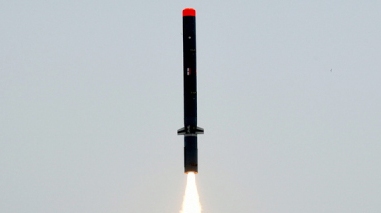Balasore: The Defence Research and Development Organisation (DRDO) Monday test fired the sub-sonic cruise missile ‘Nirbhay’ from the launch pad no-3 at the Integrated Test Range (ITR) at Chandipur off Odisha coast at 10.33 AM.
DRDO officials said that the missile developed snag during the flight test and the details of the snag were being ascertained, a DRDO official was quoted as saying.
‘Nirbhay’, developed indigenously by the DRDO, is a long-range sub-sonic cruise missile capable of deep penetration into the enemy territory to strike high-value targets with precision. The missile has a strike range of 800 km.
The missile is powered by a solid rocket motor booster and with a turbo-fan engine, is guided by a highly advanced inertial navigation system. The missile is capable of carrying 24 kinds of war weapons and able to target multiple places simultaneously.
The missile has a length of 6 metres, width of 0.52 metres, a wing span of 2.7 metres and weighs about 1,500 kg. It can carry nuclear warheads of up to 300 kg.
It may be noted here that ‘Nirbhay’ sub-sonic missiles have already been deployed in a limited number near the border with China. ‘Nirbhay’ missile is capable of flying at a speed of 0.7 Mach. Its flying capabilities include sea-skimming and terrain-hugging which helps it evade enemy radars.
‘Nirbhay’ is the tenth missile test-firing by India’s lead defence research organisation in the last 35 days. The DRDO’s effort to fast-track development of ‘Made in India’ strategic nuclear and conventional missiles – it has fired a missile every four days over nearly a month – comes against the backdrop of China’s refusal to step back from the Line of Actual Control.
China’s People’s Liberation Army had first clashed with Indian soldiers on the northern bank of Ladakh’s Pangong Tso lake May 5 this year, setting up a stand-off that rapidly expanded to four locations in East Ladakh.
PNN
